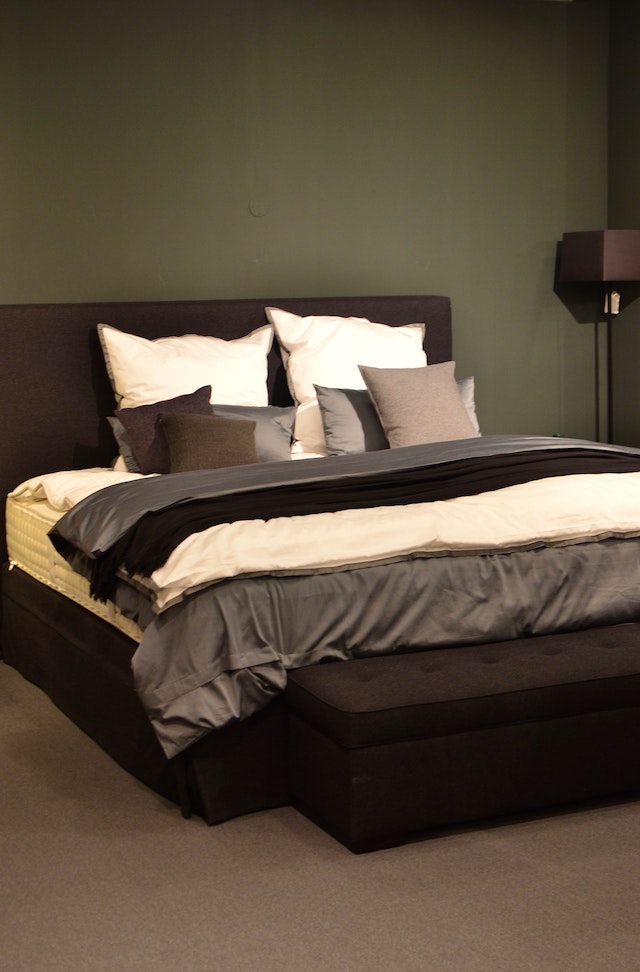The size of bed can significantly influence the quality of sleep, the style of a room, and even the dynamics of a relationship. While there isn’t a one-size-fits-all answer since bed sizes differ based on country and preference, there are standard sizes that are widely recognized and used across the bedding industry. Let’s explore the different bed sizes and their dimensions.
Twin or Single Bed:
- Dimensions: Approximately 38 x 75 inches (96.5 x 190.5 cm)
- Best Suited For: Children, teenagers, or adults with limited space.
Twin XL:
- Dimensions: Approximately 38 x 80 inches (96.5 x 203 cm)
- Best Suited For: Taller teenagers or adults, college dorm rooms.
Full or Double Bed:
- Dimensions: Approximately 54 x 75 inches (137 x 190.5 cm)
- Best Suited For: Singles who want more space or couples who don’t need as much room.
Queen Bed:
- Dimensions: Approximately 60 x 80 inches (152.5 x 203 cm)
- Best Suited For: Couples, or individuals who want a spacious sleeping area.
King Bed:
- Dimensions: Approximately 76 x 80 inches (193 x 203 cm)
- Best Suited For: Couples who want maximum personal sleeping space, those with children or pets who might join them in bed.
California King:
- Dimensions: Approximately 72 x 84 inches (183 x 213 cm)
- Best Suited For: Taller people or couples looking for length rather than width.
Contents
International Variations:
While the aforementioned sizes are standard in the United States, bed sizes can vary by country. For instance, in the UK, the sizes are somewhat different and have unique names, such as “Small Double” or “Super King.” It’s always a good idea to check the specific measurements if purchasing a bed or bedding outside of your home country.
Points to Consider:
- Room Size: Always measure the room before purchasing a bed to ensure there’s enough space for other furniture and to move around comfortably.
- Future Needs: Think about how long you’ll be using this bed. A child might outgrow a twin bed, so planning ahead can save money in the long run.
- Bedding Costs: Larger beds often mean more expensive bedding. Consider the ongoing costs of sheets, blankets, and duvets.
- Sleeping Preferences: If you or your partner move a lot in sleep, a larger bed might be more comfortable.
Choosing the right bed size is crucial for a good night’s sleep and overall bedroom satisfaction. By understanding standard sizes and assessing personal needs, you can make an informed decision that promises comfort and style for years to come.
Chart Table size of bed
Of course, I’ll attempt to format the bed sizes into a more compact and simplified table using textual representation. You can use this format to visualize the table or transpose the information to a graphical table in a software of your choice:
+—————–+—————————+
| Bed Size | Dimensions (inches) |
+—————–+—————————+
| Twin/Single | 38 x 75 |
+—————–+—————————+
| Twin XL | 38 x 80 |
+—————–+—————————+
| Full/Double | 54 x 75 |
+—————–+—————————+
| Queen | 60 x 80 |
+—————–+—————————+
| King | 76 x 80 |
+—————–+—————————+
| California King | 72 x 84 |
+—————–+—————————+
When translating this information to a graphic representation, ensure you select appropriate formatting options to make the table clear and legible for your intended audience.
What are the bed sizes in UK?
Bed sizes in the UK differ slightly from those in the US. Here’s a breakdown of standard UK bed sizes:
UK Bed Sizes:
Small Single:
- Dimensions: 75 x 190 cm (30 x 75 inches)
- Best Suited For: Young children or rooms with very limited space.
Standard Single:
- Dimensions: 90 x 190 cm (35 x 75 inches)
- Best Suited For: Children, teenagers, and adults with limited space.
Small Double (often referred to as a ‘Three Quarter’ or ‘Four Foot’ bed):
- Dimensions: 120 x 190 cm (47 x 75 inches)
- Best Suited For: Singles who want more space or for guest rooms.
Double:
- Dimensions: 135 x 190 cm (53 x 75 inches)
- Best Suited For: Couples or individuals wanting a wider bed.
King:
- Dimensions: 150 x 200 cm (59 x 79 inches)
- Best Suited For: Couples who prefer a spacious sleeping area.
Super King:
- Dimensions: 180 x 200 cm (71 x 79 inches)
- Best Suited For: Couples who want the maximum sleeping space available.
Emperor:
- Dimensions: 200 x 200 cm (79 x 79 inches)
- Best Suited For: Those who want an even larger bed, usually for luxury and space.
Large Emperor:
- Dimensions: 215 x 215 cm (85 x 85 inches)
- Best Suited For: Those seeking an expansive, luxurious sleeping space.
These sizes are standard measurements in the UK, but always remember to check specific measurements when purchasing a bed or mattress, as brands might have slight variations. Similarly, when buying bed linens, ensure they match the UK bed size you have chosen.
Example of the size of bed
Sure, when we refer to mattress sizes and dimensions chart as an “example of the size of bed,” we’re essentially picking a specific bed size and detailing its dimensions. Let’s look at a specific example from both the US and UK standards to give you a clearer idea.
US Example
Queen Bed:
- Dimensions: Approximately 60 x 80 inches (152.5 x 203 cm)
- Description: The Queen size bed is a popular choice among couples or single individuals who desire a spacious sleeping area. It offers ample space for two adults to sleep comfortably without taking up as much room as a King bed, making it a suitable choice for medium-sized bedrooms.
UK Example
Double Bed:
- Dimensions: 135 x 190 cm (53 x 75 inches)
- Description: The Double bed in the UK is designed for two people, though it can be a spacious option for a single individual as well. It’s a common choice for couples who have smaller bedrooms or for single adults who want more sleeping space than a single bed provides.
These examples showcase typical bed sizes from both the US and UK. Always remember to consider the size of the room and personal sleeping preferences when choosing a bed size.
Tips for selecting the size of bed
Selecting the right bed size is more than just measuring space. It’s about ensuring comfort, meeting individual or couple’s needs, and balancing aesthetics with functionality. Here are some tips to guide your decision:
Assess Your Space:
- Measure the Room: Always measure your room first to determine how much space you have.
- Account for Other Furniture: Remember to leave space for other bedroom furniture and ensure you can move around comfortably.
- Consider the Layout: Think about where windows, doors, and built-ins are located.
Think of the Future:
- If buying for a child, they might outgrow a small bed faster than you think.
- Are you planning on moving homes soon? Will the bed size be appropriate for a potential new space?
Evaluate Your Sleeping Habits:
- Do you move around a lot? If so, a larger bed may be more comfortable.
- If you’re a couple, think about both of your sleeping habits.
Comfort is King:
- Even if a bed fits in your room, will you be comfortable in it?
- Larger beds can offer more comfort, especially for couples, but they also consume more space.
Budget Considerations:
- Generally, larger beds and mattresses are more expensive.
- Think about the cost of bedding as well. Sheets, blankets, and duvets for larger beds can be pricier.
Style & Aesthetics:
- A bed that’s too large can overwhelm a room, while one that’s too small might look out of place.
- Consider the style of the bed frame and how it fits with the size you’re considering.
Lifestyle & Flexibility:
- If you often have guests, a bigger bed or a guest room with a decent-sized bed can be a boon.
- If you love reading or working in bed, or if pets often join you, you might appreciate the extra space a larger bed provides.
Check Bedding Availability:
- Some bed sizes, especially non-standard ones, might have limited bedding options. Ensure you can easily find and purchase sheets and covers for the bed size you choose.
Try Before You Buy:
- If possible, lie down on a mattress of the size you’re considering in a showroom.
- For couples, try it out together to ensure there’s enough space for both of you to sleep comfortably.
Remember International Differences:
- If you’re buying a bed or mattress from another country, check the size specifications carefully, as there can be variations.
Selecting the right bed size is a combination of practical considerations and personal preferences. By taking your time and assessing all factors, you can ensure you make a decision that will lead to many nights of restful sleep.
Tricks for selecting the size of bed
While there are logical “tips” for selecting the right bed size, there are also some clever “tricks” that can help you visualize and decide on the perfect bed size for your needs:
Tape It Out:
- Use painter’s tape to outline the dimensions of the potential bed size on your floor. This gives you a tangible visual of how much space the bed will occupy.
Cardboard Cut-out:
- If you have large pieces of cardboard, cut them out in the shape of the bed size you’re considering and lay them where you plan to place your bed. It’s another way to get a feel for its presence in the room.
Bed Linen Trick:
- Before buying a larger bed, buy the bed linen for that size first (like a duvet or top sheet). Drape it over your current bed to see how much larger the new size would be.
Virtual Room Planners:
- Many furniture stores offer online tools where you can virtually arrange furniture pieces, including beds, in a room template that matches your room’s dimensions.
Pillow Layout:
- Lay out pillows in the size of the bed you’re considering. For instance, for a king-size bed, you could lay out king-sized pillows in its shape.
Consider Modular Beds:
- Some beds come with modular designs that allow expansion from a single to a double or more. If you’re uncertain, such a bed can provide flexibility.
Photograph & Edit:
- Take a photo of your bedroom and use simple editing tools or apps to superimpose an image of a bed of the desired size onto the photo.
Sleep on It (Literally!):
- If you’re thinking of downsizing your bed, sleep on one half of your current bed (or the approximate size you’re considering) for a few nights to see if it’s comfortable.
The Doorway Test:
- Ensure that whatever bed size or frame you choose can fit through your doorways, halls, and staircases. Some bed frames can be quite large, so always measure first!
Room’s Focal Point:
- In most bedrooms, the bed is the focal point. Ensure the size you choose complements other elements in the room without overwhelming them.
Check the Return Policy:
- If you’re still uncertain after all your tricks and tests, ensure you purchase from a store with a good return or exchange policy. This gives you a safety net in case you change your mind after the bed is delivered.
Remember, the ultimate goal is to select a bed size that ensures comfort, fits well in your space, and complements the aesthetics of your room. Using these tricks can help bridge the gap between imagination and reality when it comes to visualizing how different bed sizes will fit in your space.

Frequently Asked Questions about the size of bed
Here are some frequently asked questions about the size of beds:
- What is the difference between a Full bed and a Queen bed?
Answer: A Full bed, also known as a Double bed, typically measures 54 x 75 inches. A Queen bed is larger, measuring approximately 60 x 80 inches. The main difference is in the width, with the Queen providing an additional 6 inches of space.
- Is a Double bed big enough for two people?
Answer: While two adults can sleep on a Double bed, it may feel a bit snug. It offers each person a width of only 27 inches, which is less than a crib’s width. For more comfort, many couples prefer at least a Queen size.
- What bed size is best for a guest room?
Answer: Queen beds are versatile for guest rooms because they can accommodate both single guests and couples. If space is limited, a Full or Double bed can also work.
- Why would someone choose a California King over a regular King bed?
Answer: The California King is 4 inches narrower and 4 inches longer than a standard King. It’s often chosen by taller individuals who need extra legroom, or for rooms that are longer than they are wide.
- Do UK and US bed sizes differ?
Answer: Yes, bed sizes and their naming conventions vary between the US and UK. For instance, a US King size is similar to a UK Super King. Always check specific dimensions if purchasing internationally.
- How much bigger is a Queen than a Twin?
Answer: A standard Twin bed measures 38 x 75 inches, while a Queen measures 60 x 80 inches. This means a Queen is 22 inches wider and 5 inches longer than a Twin.
- Is bed size linked to mattress size?
Answer: Yes, the size of bed frame corresponds to the size of the mattress it’s designed to hold. It’s crucial to match the mattress size with the bed size when making a purchase.
- How do I know if a bed will fit in my room?
Answer: Measure your room’s dimensions, considering all doors, windows, and built-ins. Leave space for other furniture and ensure you can move around comfortably. It’s often recommended to mark out the bed size on the floor using tape to visualize.
- Can I fit a King bed in a 10×10 room?
Answer: While it’s technically possible, it might not be practical. A King bed would dominate the space, leaving little room for other furniture or movement. It’s essential to consider not just the fit, but the functionality and aesthetics of the room.
- What’s the largest bed size available?
Answer: Commercially, the largest standard size is the California King or Super King, depending on the region. However, some specialty stores and manufacturers offer custom sizes that can be even larger, such as the Emperor or Large Emperor in the UK.
These are general answers and might need to be adapted to specific situations or preferences. Always make sure to measure and do thorough research when considering bed and mattress sizes.
Conclusion:
The size of bed is pivotal not only for ensuring a comfortable night’s sleep but also for harmonizing with the space and layout of a room. Different bed sizes cater to varying needs, from individual sleepers to couples, from children to tall adults, and from snug bedrooms to spacious suites. While standard sizes like Twin, Full, Queen, and King are commonly recognized in the U.S., it’s crucial to acknowledge variations like the UK’s Double, King, and Super King sizes.
Choosing the right bed size is a blend of practical spatial considerations, personal comfort preferences, and aesthetic appeal. It’s also essential to recognize that what’s standard in one country might differ in another, underscoring the importance of always checking specific measurements, especially when shopping internationally.
In the quest for the perfect bed size, it’s not just about fitting a mattress into a room; it’s about ensuring a restful, rejuvenating sleep in a space that feels both inviting and functional. Whether you’re an individual seeking sprawling luxury or a couple looking for cosy intimacy, there’s a bed size out there that’s just right for you.







